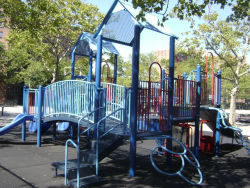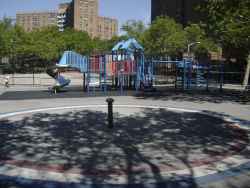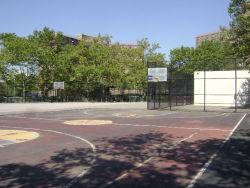Randall Playground
Randall Playground
Randall Playground serves the residents of the Castle Hill Houses. This sprawling group of buildings is one of the housing projects built under the leadership of City Housing Commissioner Philip J. Cruise (1898-1976) and Robert Moses (1888-1981). The project was approved in March 1954. Many former residents of East Tremont relocated to Castle Hill after their homes were demolished to clear a path for the Cross-Bronx Expressway construction.
Questions persist regarding Moses’s involvement in the operation. His triple role as Chairman of the Triborough Bridge and Tunnel Authority, Construction Coordinator, and Member of the City Planning Commission gave him control over the building process from start to finish, including the location of the new highway, the consequent demolition of housing stock, and the construction of new buildings. Several Moses associates made huge profits from shares in the hastily organized Nassau Management Company, which obtained lucrative tenant relocation contracts.
The playground opened in 1960 as Castle Hill Houses Playground, under the jurisdiction of the Housing Department. In 1985 the land was transferred to Parks, and the playground renamed for one of its adjoining streets, Randall Avenue. The name of Randall Avenue, and those of the playground’s other border streets, Olmstead and Castle Hill Avenues, are part of a literal road map of Bronx history.
Many Bronx streets were named according to themes. A group of avenues in the south Bronx (Bryant, Whittier, Longfellow) is a catalogue of American poets. The Castle Hill area abounds in the names of ancient Greek and Roman luminaries (Virgil, Homer, Caesar, Solon), but it is the names of wealthy Bronx landowners of the 18th and 19th century, when the Bronx was still a part of Westchester County, that appear most frequently.
Olmstead Avenue falls into the landowner category. The Olmstead Family settled in Westchester County during the Revolutionary War (1776-1783). Olmsteads held various positions in the community during the 18th and 19th centuries, and Olmstead gravestones can be found in the oldest section of the St. Peter’s churchyard.
Castle Hill Avenue is also associated with one of the early Bronx families. In the 19th century, this roadway led to Castle Hill, the neighborhood’s namesake and the estate of Governeur Morris Wilkins. A century earlier, the road was known as Sheep Pasture Road, and before that it was a Native American footpath up to a fortress overlooking the Bronx River.
The namesake of Randall Avenue’s is uncertain, as there are several possibilities. One of the likeliest of these is Samuel Sitwell Randall, Superintendent of New York City Public Schools in the mid-1800s. .An alternative possibility is the Randal [sic] family, who owned Randall’s Island, as well as land in the Castle Hill area.
The playground, completed in 1960, contains adventure equipment, swings, and slides as well as London planetrees (Platanus x acerifolia) that provide shade for the area. Handball and basketball courts round out the facilities, along with benches and a public restroom.
Check out your park's Vital Signs
Clean & Safe
Green & Resilient
Empowered & Engaged Users
Share your feedback or learn more about how this park is part of a
Vital Park System




